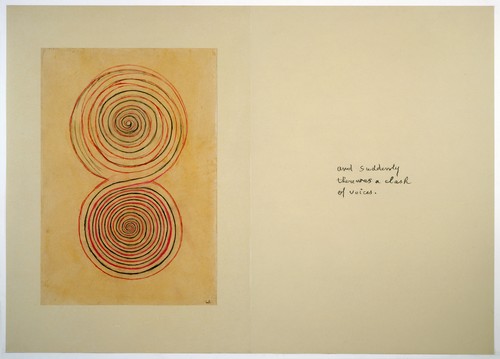Louise Bourgeois
dal 27/1/2005 al 12/3/2005
Segnalato da
27/1/2005
Louise Bourgeois
Hauser & Wirth, London
Sublimation. For over seven decades, the creative process for Bourgeois has been fuelled by an introspective reality that is unique to the artist, often visualised through an exorcism of her childhood and a frank examination of female sexuality. A variety of forms between different genres, media and materials have determined the stylistic complexity of artist's oeuvre, articulated by recurrent motifs and an intensely personal symbolism.

Sublimation
Louise Bourgeois is recognised as one of the most important and influential artists working today. Hauser & Wirth London are delighted to present Sublimation (2002), an extraordinary narrative work in mixed media, incorporating a series of the artist’s drawings and text. The pages are beautifully presented in frames, hung against the gallery’s panelled walls. The exhibition also includes two large, individual hanging sculptures, both Untitled (2004), and Be Calme (October 1st-31st) (2004), a new suite of drawings. For over seven decades, the creative process for Bourgeois has been fuelled by an introspective reality that is unique to the artist, often visualised through an exorcism of her childhood and a frank examination of female sexuality. A variety of forms between different genres, media and materials have determined the stylistic complexity of Bourgeois’ oeuvre, articulated by recurrent motifs and an intensely personal symbolism.
Sublimation (2002) is a fifteen-paged mixed media work consisting of text and drawings by Bourgeois. Each page is approximately 105 x 148 cm, individually framed, and forms a narrative of her response to witnessing a couple fighting in the presence of their child. The artist’s own traumatic memories are brought forth in her observation of the young boy displacing his emotion into a physical form – in this case by sweeping the floor with a broom. Bourgeois is talking of sublimation and considers the process a gift. For her, it provides the impulse behind her sculptural work. She ends the book, “I feel that if we are able to subliminate, in any way we do, that we should feel thankful. I cannot talk about any other profession, but the artist is blessed with this power.â€
Suspended from the gallery’s Lutyens-designed ceiling are the two large, protuberant aluminium sculptures, both Untitled (2004). They are individual works that resemble nests, each created as autonomous forms in their own right. The abstract forms are part of an ongoing series of hanging sculptures by Bourgeois and those exhibited at Hauser & Wirth have a particular affinity to a previous work entitled Les Bienvenus (1996), installed in Le Parc de la Mairie of Choisy-le-Roi, the village where Bourgeois grew up. The spiralling, interwoven sculptural forms are augmented by a natural swing through an axis, and expresses Bourgeois’ views on the fragility of marriage and relationships.
Seemingly balanced by a thread, Bourgeois applies an attitude of confidence and tenderness to the large-scale sculptures. The artist has long been an explorer of new materials in her work, experimenting with their aesthetic potential. The cool surface of aluminium is heightened by Bourgeois’ sophisticated treatment and she exudes a sure touch in the irregular mould of gentle, multiple curves. The material’s inherent qualities are thus exquisitely dramatised by subtle nuances from the effect of light.
Hauser & Wirth will also be exhibiting Be Calme (October 1st-31st) (2004), a new suite of 31 double sided mixed media drawings. Drawing plays a vital role for the artist and groups such as these abstract works are a documentation of time, for Bourgeois has not left her home since the mid-1990s. The fervent rhythms and gauze-like structures become an obsessive vehicle for recalling the past and the passing of time.
As early as 1950, Louise Bourgeois was one of the first artists to create ‘environments’, often referring to the theme of the cell and the room. She is acknowledged as a pioneer in taking art out of the frame, placing herself front and centre in the exploration of identity. In works such as The Red Room - Parents (1994), objéts trouvés and personal items placed can be read as “poetic architectures of memoryâ€. The use of the concentric or spiral form intertwines a painful life story anchored in the unconscious. Bourgeois’ work is often impregnated with fantastical and sexual connotations whose crudity and extravagance belie an apparent surrealism - a distillation of the place of childhood and youth, of sanctuary, withdrawal and isolation.
Louise Bourgeois was born in France in 1911 and has been working in America since 1938. She studied at the École du Louvre, the Academie Julian and in Fernand Leger’s studio. Her work is held in all major collections, including the Metropolitan Museum, Whitney Museum and Museum of Modern Art, New York, the National Gallery of Art, Washington, the National Galleries of Australia and Canada, and Tate Modern where she was the first artist commissioned by Unilever to exhibit in the Turbine Hall. Her major solo exhibitions include MOMA, New York (1994), the Whitney Museum of Modern Art (1998), the Serpentine Gallery, London (1998), the Guggenheim Bilbao (2001), The State Hermitage Museum, St. Petersburg (2001). Upcoming exhibitions include the Wilfredo Lam Centre, Havana (2005) and a retrospective at Tate Modern is due in 2007. Group shows include the São Paolo Bienal of 1996, and Documenta 9 in 1989; she represented the United States of America at the Venice Biennale in 1993. The artist lives and works in New York.
For further information please contact Farah Rahim Ismail at Hauser & Wirth - farah@hauserwirth.com - or Rhiannon Pickles at Idea Generation on +44 20 7428 4949 or email: rhiannon@ideageneration.co.uk
HAUSER & WIRTH LONDON - 196A PICCADILLY - LONDON
Opening hours: Tuesday to Saturday: 10am - 6pm



